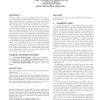Free Online Productivity Tools
i2Speak
i2Symbol
i2OCR
iTex2Img
iWeb2Print
iWeb2Shot
i2Type
iPdf2Split
iPdf2Merge
i2Bopomofo
i2Arabic
i2Style
i2Image
i2PDF
iLatex2Rtf
Sci2ools
114
Voted
KBSE
2007
IEEE
2007
IEEE
Modeling bug report quality
Software developers spend a significant portion of their resources handling user-submitted bug reports. For software that is widely deployed, the number of bug reports typically outstrips the resources available to triage them. As a result, some reports may be dealt with too slowly or not at all. We present a descriptive model of bug report quality based on a statistical analysis of surface features of over 27,000 publicly available bug reports for the Mozilla Firefox project. The model predicts whether a bug report is triaged within a given amount of time. Our analysis of this model has implications for bug reporting systems and suggests features that should be emphasized when composing bug reports. We evaluate our model empirically based on its hypothetical performance as an automatic filter of incoming bug reports. Our results show that our model performs significantly better than chance in terms of precision and recall. In addition, we show that our model can reduce the overall...
Related Content
| Added | 04 Jun 2010 |
| Updated | 04 Jun 2010 |
| Type | Conference |
| Year | 2007 |
| Where | KBSE |
| Authors | Pieter Hooimeijer, Westley Weimer |
Comments (0)

